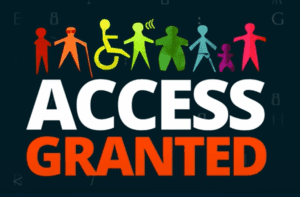One of the concerns heavy on many minds is if we will emerge from this self-quarantine less in-shape than when we entered it. Gyms are closed, and for many of us, the workouts that constitute part of our regular routine are leaving an empty space in our days. The good news is that many fitness providers are now focusing on making their preexisting online offerings widely available, or are implementing online content for the first time. For example, Healthtrax in Raleigh, now promotes online access to its group fitness routines for free for 60 days. You don’t have to be a member of the gym to gain access to these workouts, which makes this free trial a fantastic opportunity to test them out.
The problem with these classes is that even in their online format, the classes are visual. The dance moves and yoga poses are not extensively described, but rather demonstrated on screen. This makes the online courses no more accessible than the in-person classes. True, making the routines available to clients in their own homes removes the necessity for transportation, which is often a major barrier that stands between blind and visually impaired people and a good workout. But another major challenge, that of adequately describing the moves and positions in a non-visual way, remains.
However, therein lies a major opportunity: With the current order to stay at home, there is already an increased focus on making workouts available online, and in many cases, free for a limited time. In theory, it would take a small step to expand this focus to include accessibility for all. For example, instead of encouragement, the trainer monologues in the videos could be shifted to include more descriptions of their physical movements. Alternatively, fitness providers could add short optional video tutorials that explain steps and positions in more detail. This would require little editing and the use of pre-existing content. For example, once yoga positions are described and learned by name, BVI participants can easily follow a workout where the positions are called out. A more involved proposal includes the establishment of video conferencing in which a participant could enact position or movement sequences, and a trainer could correct their form in real time. Most personal trainers are currently unable to do their jobs, and this proposal would create work for them AND recruit and train a huge segment of the population. Perhaps, once this is over, these new exercisers might choose to keep it up, join an in-person gym, or continue a relationship with a personal trainer.
Currently, most online workouts do not have any of these accommodations in place. But there are places where those who are blind and visually impaired can get a free online workout that is tailored to their needs. One such place is BlindAlive, which consists of a website as well as an app, both completely free of charge. They offer what they call Eyes-Free Fitness: MP3 files that can be played from any computer or phone, and offer non-visual exercise cues. The workout menu is quite dynamic, and offers cardio, Pilates, yoga, and strength training. Sadly, BlindAlive seems to be one of a kind, in terms of offering exercise programs that blind and visually impaired people can do from home.
But we can change that. In these times of self-quarantine and social distancing, fitness is all the more important. When we are forced to be sedentary, we need to find ways to stay active. This goal must be accessible to all of us, including people who are visually impaired. This demographic is already afflicted by lower-than-average fitness levels: 50 percent of adults with a disability, according to the CDC, get little or no physical activity (https://www.cdc.gov/mmwr/preview/mmwrhtml/mm6318a5.htm). Now more than ever, we have both the urgency and the opportunity to fix this.
If you can think of additional ways to make home-based exercise routines accessible, or if you know of fitness providers who offer this, please contact us.





